In this article, one of the biggest statistics at this moment reveling the feeling of the people about blockchain will be analysed, providing some characteristics of the people who were involved in the collection of the data.
The data in this article is based on the annual developers survey made by StackOverflow. Taking their description, for anyone who haven’t heard about Stack Overflow before, here are a few words:
Founded in 2008, Stack Overflow is the largest, most trusted online community for anyone that codes to learn, share their knowledge, and build their careers. More than 50 million unique visitors come to Stack Overflow each month to help solve coding problems, develop new skills, and find job opportunities.
Each year on this platform, a survey is created for developers in order to get some insights about where the development world is going. Here you can see the survey results from each year the survey was held, with a number of respondents variating from ~2500 in 2012 to over 100,000 in 2018. This year there were exactly 88,883 respondents to the survey, which makes it a pretty relevant statistics. One of the best things at this survey and the approach of the guys from StackOverflow is the fact that they don’t sell this data (as other companies may have but I don’t want to point fingers or give names here), instead they are anonymizing them and provide them for free to anybody to process them and gain any insights about developers that they want to. Some of the questions in this survey are suggested by the community, and other questions are decided by the StackOverflow team.
This year, as with the evolution of the price of cryptocurrencies, but also as the blockchain technology gained more popularity, the survey had an uncommon question about what is the people opinion about blockchain. The question was not proposed by the community (shame on us) but it was there, so it once more revealed the progress that the blockchain technology makes to mass adoption.
The question was formulated like this: “Blockchain / cryptocurrency technology is primarily:” and the possible answers were:
- Useful across many domains and could change many aspects of our lives
- Useful for immutable record keeping outside of currency
- A passing fad
- An irresponsible use of resources
- Useful for decentralized currency (i.e., Bitcoin)
And these answers were the only answers analyzed by the guys at StackOverflow on their results page, a question on which 60,165 people answered. At first sight anybody would think this are the data that should give us the feeling of the people about blockchain, from useful across many domains (the best case for blockchain) to a passing fad (hope not), but if you look closely, you would see another category of people: the people who skipped the question.
Since it is such a simple to answer question and the entire survey took ~30 minutes to complete, we can easily exclude the case in which people were discouraged by the length of the question or the length of the answer that they need to complete. The truth is that people skipped the question and I am sure of that because the next question, a very interesting one about the better life of people born today was answered by almost all the participants to the survey. Considering this, it is safe to say that plenty of people, 28718 to be precise, skipped answering the question about blockchain.
Avoiding answering the question is maybe the worst case for blockchain opinion among people, because it can mean that the question itself is not relevant or it is not worth answering, or even that those people do not have any opinion about blockchain yet. If it is the later case, somebody who wants to promote the blockchain and to get it mainstream has to target this area, maybe with ads or with technical articles or why not, cryptocurrencies. Keep in mind that these people whose answers are analysed below are developers, so the chances that they have been exposed already to the blockchain are far greater than regular people who do not have a solid programming or technical background. In the more general case, this sixth category may be way bigger than the one in the current survey.
Starting from the current data, I was able to distribute the answers of each respondent to one of the six categories defined by their perception about blockchain. In percents they look like this:

This kind of graphic is similar to everything StackOverflow provides us in the statistics that they published within the results article. Now, bare with me in getting a feeling about who these people are and why they have the tendency to answer the survey the way they did. It will be a long way, but in the end you will better understand what kind of people trust more the blockchain technology, and get some insights about why people are still reticent to the blockchain trend.
From this point on, all the data will be analyzed mostly in the same way for each different topic. The answers will be distributed by each category that can be created by the answers to each other question analyzed, converted in percents and compared between each opinion about the blockchain. Because the understanding of this technique may not be obvious at the beginning as well as why the data was approached this way, I will give as an example the answers of the developers at the question about their gender, excluding the people who answered anything other than woman or man, not because I have any personal opinion about this answer, but because they were very few respondents in a third category and their answers can be left aside for simplicity reasons, as they do not impact the statistics about blockchain in a meaningful way. I will include though all the answers to the question, as well as their opinion about blockchain, for transparency reasons.
By gender, the number of the answers, distributed by the opinion about the blockchain look like this:

As you can see, we can not easily compare the number of male respondents to the number of female respondents by their opinion about blockchain since they are 77,919 men and 6,344 woman answering the survey. In this case, to still get meaningful representation of the data, each category of respondent by gender is distributed by their opinion about blockchain, as in the table above, but in percents. After the conversion to percents, the data in the table above looks like the following:

Having the number of responses represented in percentages per each category makes it way easier to interpret the data, as we can very simply compare them and see that for example men tend to see blockchain way useful than women do when it comes to its usefulness about many aspects of our life, because we can spot the difference easily between 20,38% men and 15,53% women choosing this answer.
Moving on, from this point, I will not show the raw data in the tables for each answer type that has been analysed, but I will only show the final graphic that has been created, in order to keep the article short and the data still meaningful and easy to follow. By the end there are analysed eight characteristics of the respondents:
- Gender (as the responses in the example above)
- Age (age groups and average)
- Education
- Work experience (same as age)
- Opinion about the future
- Coding as a hobby
- Contribution to open source
- Taking care of dependents (including children but not only)
In order to finish the analysis of the answers per gender, I will add the table illustrating the data in the table above, with some comments:
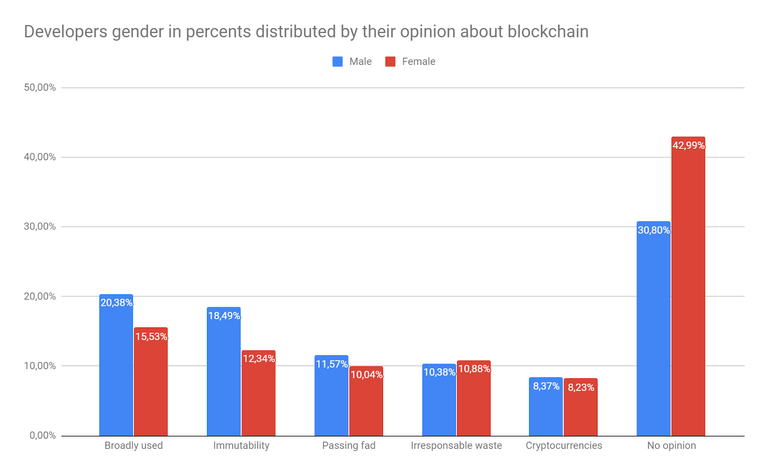
Now it is easy to see that women use to perceive blockchain less useful than men, with lower numbers on each category that is pro this technology. Women tend to see blockchain as a irresponsible waste of resources more than men do, but with only a tiny difference of about 0,5% in their category. Besides that, we can see that women avoided answering the question about blockchain with a way bigger percentage than men did, as we can see the comparison between 30,80% men and 42.99% women. It may not be safe to conclude that women are more reticent in front of new technologies than men, but this is something that the percentages suggest. Maybe it is the difference in risk taking that men may have higher than women, or maybe it is the curiosity oriented to technology “cool” or “geek” stuff that women may not be so thrilled about, or something that I am not seeing yet.
The only safe conclusion at this point that can be taken is that men were more likely to adopt blockchain than women at the beginning of the year, when this survey was made. I will let you take your own conclusions about this data, while I’ll keep staying in the safe zone and move on to the next question at which the developers answered.
Developers' age
Firstly the developers age is shown in the image below as an average per each category of opinion about blockchain.
You can see that the average age in years per each category do not offer much information about developers that have different opinions about blockchain. The aspects that really look obvious in this graphic are that people who are usually older tend to see blockchain technology as an irresponsible waste of resources and people that are younger seem to perceive blockchain as a technology useful for cryptocurrencies. It should be natural for people older to have a high sense of responsibility and think about the huge amount of energy that is used by the proof of work algorithms that stay behind big blockchains like Bitcoin or Ethereum so this would explain their tendency to see blockchain as an irresponsible waste. At the same time, people younger may be more concerned about their success that they should have in their career path, and this may be the reason behind their tendency to think about blockchain firstly as some technology that powers up cryptocurrency, instead on focusing of others aspects of it. On the other hand, you may think about the people that perceive the blockchain technology as an irresponsible waste as people that are ignorant as they refuse to see the other alternatives of implementation for the blockchain like proof of stake or even delegated proof of stake, but besides that, at the current moment, the most popular blockchains are still proof of work based so their vision is still legit.
Now, in order to get more relevant graphics, the age results were split in age groups as follows:
- Below 20 years
- 20 to 30 years
- 30 to 40 years
- 40 to 50 years
- Over 50 years
The age results were split at this phase to get a pretty balanced number of answers per each category, while preserving the differences between the age groups.
At this point, the differences between each category are represented in the graphics below:
This is one of the most relevant graphics if you ask me. It displays people believing the most in blockchain, distributed by age in percents. If you remember, the best perception that somebody could have about blockchain was that it is “useful across many domains and could change many aspects of our lives”. In order to keep the title of the graphic simple and still relevant, I summarised that as broadly useful. We can see that this perception of people about blockchain decreases as they are older which says plenty of things. One of them is that younger people are the most enthusiastic about new trends in technology, while they are optimistic about the possibilities that blockchain can offer to this world. On the other side, some people may create a correlation between this excitement and the naivety of younger people who have not yet seen many ideas that seemed good at the beginning, becoming obsolete and proving themselves useless.
Older people may have a more mature vision about new technology, approaching it with skepticism and see the downsides in it, or just preferring to keep a safe and reserved attitude when interacting to new trends. In this older people tendency to see blockchain less useful some may say that older people today were still old a few years ago when blockchain started to gain momentum and become popular, and they may have firstly heard of it at a more mature age, when some become less interested in new technology, and this may be the reason why older people do not feel enthusiastic about blockchain.
I will let you take your own conclusions about this graphic while we move to the next one.
This one is another very relevant graphic, because it shows the correlation between a technical perception of the blockchain and the age of the respondents. This graphic is backed by a similar one in the graphics from the experience topic that will be shown later in the article.
Since this perception about blockchain is more technical than than the first one, we can see in this category less young people and more people as the age increases, as well as a small decrease in percentages of people who are 50 years plus, which can be correlated with the previous graphic.
For this category there is a small number of people who do not mention their age, but they chose to say that immutability applications is the usage that fits best the blockchain, which suggests that these people really understand the blockchain behinds, but also value their privacy.
People in this category have the age percentages pretty close to each other so I won’t be saying that it is defining any of the age ranges, but we can still see a tendency of older people to see blockchain as some ephemeral technology trend. This may be because older developers are usually seeing technologies rising and then falling and getting obsolete with time, and they may be trained in this way of thinking.
The truth is that pretty few programming languages and frameworks are still alive on the market after 20 years from the point they were launched so from this point of view, older developers may be right seeing blockchain as something that will not make it in the end. This should be somehow to the waste of resources, but that is a different mindset since it is more oriented on the proof of work implementation and not on the actual blockchain technology.
Since the numbers were close to each other for each age range, this graphic was somehow not that relevant, other than the fact that no matter of age some people believe that blockchain is not here to stay in any of its forms from crypto, to immutable records representation.
Between people who see blockchain as an irresponsible waste of resource, the most numerous in age ranges are the people between forty and fifty. As you would have expected, younger people do not usually think about the energy that is wasted on mining and the equipment designed solely for this purpose. Some may say that younger people may not even understand the proof of work algorithms at the same time not realizing that some blockchains require plenty of energy to be run, but this is often not the case among respondents.
Since the respondents are developers, and it is safe to say that almost all of them are developers since they have a StackOverflow account and they went through over fifty questions before reaching this one without getting super bored (it would have had no point to invalidate the survey so we’ll exclude this option), they can understand what PoW is and why it is bad for environment. Another reason why I would say that developers are aware of the PoW and they still do not consider it such a negative side of the blockchain is the fact that not only the developers below twenty years old are usually not seeing blockchain as an irresponsible waste of resources, but people below thirty also do not see it as a waste, and developers by that age should have sufficient knowledge to understand these concepts.
One possible explanation for this graphic can be that younger people do not think about environment and how are we using resources like electrical energy, whereas pretty old people realize that is an issue, but they do not care so much, or they do not care about blockchains at all.
I am sure you would have bet that people below twenty (I usually call them kids) think about money and how to get rich quick. But I also bet that you wouldn’t have expected that the graphic of age ranges will look dramatically in the favour of people below twenty years old when it comes to usage of blockchains as decentralized cryptocurrency. I know that it numbers they differ, but as they are distributed in percentages, the people below twenty are more confident in blockchain as cryptocurrencies than all the people over thirty.
You can call it generation Z or however you like, but in the end this is how it looks, younger people are more likely to get into cryptocurrencies than any of us, so if we see the things from this perspective, we can expect great future ahead of crypto, especially in a few years, when these young folks will start working and getting paid as they can start investing real money (some of them may already be investing, or ar far richer than us, who knows?).
Of course the interest in blockchain as part of a cryptocurrency passes with time so as people are older, they do not care so much about crypto, maybe because it is hard to adapt to new trends, or maybe because some investment that could bring value in a matter of years does not sound tempting anymore.
I will let you think more about this amazing graphic and the insights that it provides, while I leave here the final graphic on the age topic, before moving to the next one.
As shown in the graphic above, there is a big correlation between the people who skipped answering the question about blockchain and the people who skipped answering the question about their age. For this particular case, given the fact that the question about age is one of the most important ones from the whole survey, I think that this category of people can be safely ignored when taking conclusions. They are the people who usually do not answer.
Besides the people who refused to tell their age, we can see that every age range got almost the same percentages of people not having any opinion about blockchain. People between thirty and fifty years tend to have more to say about blockchain than people in any other age range, which could be also due to their working experience or because of their sense of responsibility.
This was the section regarding the age related statistics and how people perceive blockchain depending on their age. Now, because they are highly correlated, we will move to the section regarding developers experience.
Developers' experience
The responses of developers will be analyzed just as for age, at first as an average, and then each category separately, on intervals of experience, containing the category of responses in percentages for developers with ages:
- under 2 years
- between 2 and 5 years
- between 5 and 10 years
- over 10 years
- NA meaning they skipped the experience answer
The intervals were chosen so that the numbers of the responses in each of them are pretty balanced, so we can get some relevant insights about the experience of the developers and how it is correlated to their opinion about blockchain.
The graphic above seems pretty familiar, since it has the same shape as the average age per each category of opinion about blockchain, but this time the numbers are more outstanding. The differences between the average experience of developers who think that blockchain is mainly useful for cryptocurrencies is way lower than the average work experience of people who think that blockchain is an irresponsible waste of resources.
This huge gap does not always mean that one category is more right about the usage of blockchain, as we should not value quantity be it even in years over quality of perception, but still the more experienced opinions don’t come easy.
Another young category to development area is the one of people perceiving blockchain as useful across many domains, with the possibility to change many aspects of our lives. This may happen because developers who are still young to this field may have more energy to explore new technologies, or just because there is a high correlation between the experience and age, and at a younger age people tend to be more enthusiastic.
Now, exactly as in the case of age, we will be analyzing individually the experience range for each category in order to get more insights about it, and it will be the last topic that is analysed per each category individually in this article.
The legend stands for experience in years, where blue means people that have less than two years of work experience in software development, red represents the people with the experience range between two and five years, and orange (NA) is the people who refused to mention their experience, but that expressed their opinion about blockchain.
This diagram is, as you would have expected, very similar to the one representing the age of the people thinking blockchain is useful across many domains. The trend of people believing less and less into blockchain is the same, as people have more experience, and the fact that not so experienced developers (even less than two years) are the most confident in blockchain makes me suspicious a bit.
The graphic could just represent the people that do not want to explore new technologies as they already know plenty of things and do not have that energy anymore to learn about blockchain, or it can mean that given their vast knowledge, experienced developers refuse to believe in blockchain because of some reasons.
This graphic looks better than its correspondent in age, because here we can clearly see the trend of people seeing blockchain useful for immutability applications, as they get more experienced. This trend is natural, as more experienced developers understand better the concept of immutability, as well as the blockchain and what exactly makes it immutable.
Another thing that is pretty remarkable is the low number of people who refused to express their work experience and still chose immutability applications as the primary use of blockchain in the real world. It is clear to see that people who do not mention their experience (whether because they do not have much, or they don’t like sharing personal data) usually chose other categories than immutability. This makes me believe that a big part of them are experienced developers who want to remain anonymous, given the current trends, but it is nothing more than a supposition.
My comments for this graphic are almost the same as for its homologue in age, because there I mentioned the tendency of experienced people to perceive new technologies as something that will eventually pass, because they have witnessed a similar cycle for plenty other job related technologies. This mindset will sound like “From frameworks to best practices and programming languages, they all eventually pass or change, so the same way may blockchain become obsolete”.
Even though this feeling is not so pleasurable for crypto investors or blockchain enthusiasts, it is still there, and at some point it can become reality so it is worth taking it into consideration.
Looking at this diagram we can easily see that, in contrast to others, pretty few people were tempted to see blockchain as an irresponsible waste of resources. This was the second less chosen category, after the usage as powering cryptocurrencies where we already know that young developers were the top voters.
Yet again, this diagram correlates with the one from age, but this time, we can see that the aspect of age was the one making people not to see blockchain as an irresponsible waste in the case of older individuals, not the experience. In the age graphic, people over fifty years old were not seeing so much blockchain as an irresponsible waste, as people between thirty and fifty do, but here, as people get more experienced, they tend to perceive blockchain as a waste.
I encourage you not to stick to the negative feelings about blockchain that this graphic may give to you, because you will miss the good part of this article. In the end you may still conclude that blockchain has no future, even though I believe it is very unlikely that you will do so, but at least you will have a better informed opinion.
I don’t know about you, but when I look at this graphic I say to myself “Look, here are all the people who refused to say their experience!”. Holding back this first instinct, the 13,17% of people who did not mentioned their experience is not such a big percentage since this category was the least voted one.
It is still curious that cryptocurrencies are seen as the main use of blockchain by the developers who refused to mention their age. Once again, I suspect that they are pretty young, as the graphic correspondent to this one from age suggests, and also as the trend implies, but I can’t state for sure. It is clear on the other side that less experienced developers perceive blockchain as being useful for cryptocurrencies.
Now the last but not least on this experience topic, the people who skipped expressing an opinion
This graphic is very relevant since we can see that with their growing experience people tend to form an opinion about blockchain. Whether it is immutability or the irresponsible waste of resources, the experienced developers usually have an opinion about blockchain, while their less experienced colleagues may not have enough knowledge about it to feel comfortable expressing an opinion.
As in the previous graphic also, the people who refused to communicate their experience are the most present ones, which following the trend of this category makes me believe that plenty of these people do not have much working experience.
Developers' education
Moving to education section, here I’ve grouped the graphics into two parts, one with the closest values to each other, and the second one with a bigger gap between each category of people and education.
This first graphic of education is the one with the smaller gaps between categories of respondents answers. As you can see, the values of this graphic can be deduced easily from the responses in the age section. Younger respondents see more potential in blockchain, and there is a small correlation between the young age of the respondents and the fact that they did not got to finish a college yet. There is also a small tendency in people with higher education to see blockchain as a fad that will pass, but nothing really impressive.
What should be remarked on the other side is that people with different degrees usually have the same opinion about blockchain. From this perspective we can understand that the degree of education is almost not correlated at all to the perception about blockchain.
In this second graphic representing the education of the respondents against their perception about blockchain we can see some more impressive gaps in percents. What is curios is that postgraduate people see the blockchain more as useful for immutability based applications rather than an irresponsible waste.
The trends still exist here too, per each category. People with less education see blockchain more as a cryptocurrency platform and less as an immutability based applications, while it’s the complete opposite case for people with higher education.
Contribution to open source
Now the last topic split by ranges, just as in the last two graphics above, here we have how often do people contribute to open source split by their opinion about blockchain.
The graphic above represents the first half of categories of people by blockchain opinion correlated to their contribution to the open source code. I chose this topic also because the contribution to open source reflects some part of the altruistic character of the people. Contributing to open source may not seem much, but actually it means giving away one of your most important resources: your time.
You can see a big degree of correlation between the people who do not contribute to open source at all and people who don’t have any opinion about blockchain. These people are not that interested in the new technologies or don’t have time to learn about it. Being good or bad, at least the people contributing to open source are more likely to have an opinion about blockchain.
Another interesting trend is that people who contribute to open source to see blockchain more of an irresponsible waste of resources, much more than the people who do not contribute to open source. Actually the percentage of people that contribute to open source and think that blockchain fits this category is double than the percentage of people seeing blockchain the same and not contributing to open source (14,28% vs 7,99%).
I personally like this graphic because it is easy to see how people have a generally good opinion about blockchain, and this increases also with the frequency of people contributing to open source. The percentages of people thinking that blockchain is a passing fad or good for cryptocurrencies do not seem to correlate very much to the contribution of people to open source.
It is expected to have higher percentages for people contributing to open source in all of the categories of people expressing an opinion since there are so much people who do not contribute to open source and who have also skipped the question about blockchain.
Coding as a hobby
The percentages under the topic of people coding as a hobby should tell us the same story as the percentages of people contributing or not to open source software, but as that one is split by frequency intervals, these graphics offers us slightly different insights.
Looking at the graphic which illustrates how people who code as a hobby contribute to blockchain, we can easily see that their involvement is way bigger in this technology than the ones who do not write code in their spare time.
At least for me this is almost all that the graphic above describes, since the big difference between the people who expressed an opinion about blockchain and the people who did not is distributed across all the other categories of people perceiving blockchain in any other way. In spite of that, since the percentages of people thinking about blockchain as a passing fad no matter if they are coding as a hobby or not, tells me that people who do not code as a hobby usually think more of blockchain that it is something ephemeral.
Dependents
Since having children or other dependents to take care of may influence the time that developers spend on learning about new cool stuff on the market, I have added this topic to the list of analyzed topics, and it seems that this feeling was right, since this graphic offers some good insights about who are the people believing or not in the blockchain.
In this graphic we can easily see that as we guessed, people who do not have children or any other dependents usually have a better defined opinion about blockchain. From this point of view it is interesting to see that people who take care of dependents do still manifest hope because they still see blockchain as broadly useful more than the other category and much less as a passing fad or irresponsible waste.
From this graphic we can conclude that the perception of the blockchain among people (I haven’t said developers because we are now looking more at these people from a personal aspect rather than technical) can be correlated with the social and psychological aspects and not only with the technical details of different implementations of blockchain.
In this regard, our last graphic will reveal how much the psychological aspects influence people’s opinion about blockchain, which is very interesting because after all, no matter how good a product is, it may or may not have success depending whether the people believe or not in it.
Perception about the future
In my opinion this last topic is the one that has the most impact on how people perceive blockchain.
Here you have it. In this graphic it we analyze the opinion of people about blockchain, in contrast to their perception about the future. Isn’t it amazing?
The current graphic shows that there is a very high correlation between how people perceive blockchain and also the future.
The percentage of people believing that blockchain is an irresponsible waste of resources is almost twice for the people who have a negative perception about future than the percentage of people believing the people born today will have a better life than we did. The percentage of people thinking blockchain is a passing fad is higher for people who have less hope for the future.
On the other side, people having a more positive vision are dominating all the other “positive” types of perception about blockchain. There is a very big correlation between how people are perceiving blockchain and how they see the overall future since in all the positive areas of the blockchain, the percentages of optimists are higher and lower, and for the negative areas of blockchain perception, the percentages of pessimists are higher.
Right now the discrepancies are not that big between these two categories of people (optimistic and pessimistic), but this is solely because there are more than 30% of the respondents who did not had any opinion about blockchain. From this perspective, the differences from each category are huge.
As a matter of information and public opinion, blockchain has a long way before it is adopted, and considering the time it spent around and how far did it get, it may take plenty of years at this phase to get to mass adoption (cryptocurrencies included, but also as immutable records representation and other applications immutability related) if it ever gets mass adopted.
If you look for investments in the cryptocurrencies zone, then you may have still plenty of time because cryptocurrencies as they are backed by blockchain (at least the more serious ones) are still at the beginning, but you have to take into consideration the risks also behind this young technology.
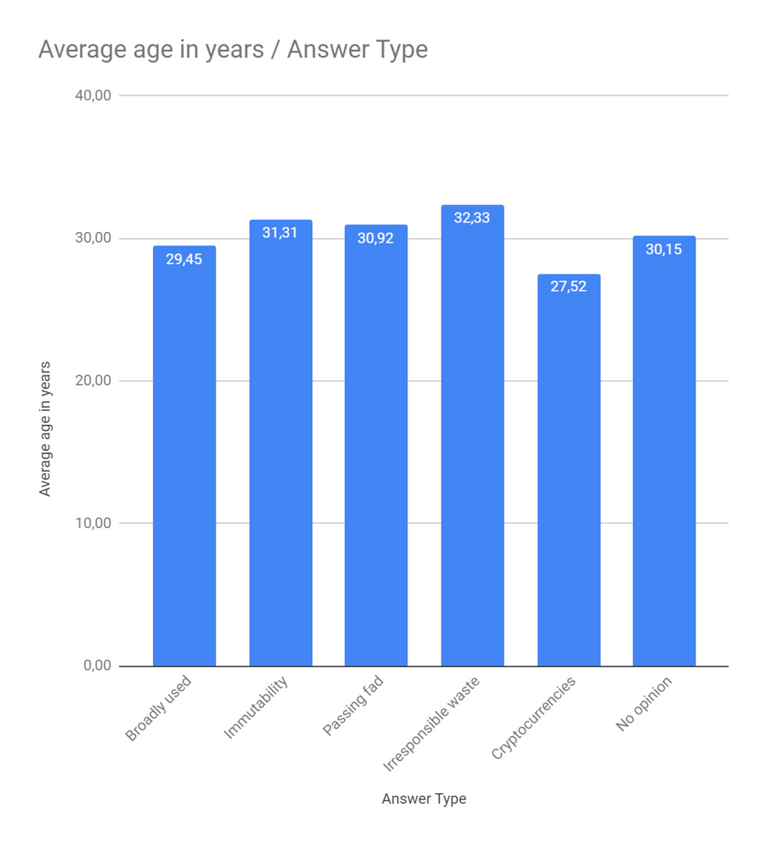

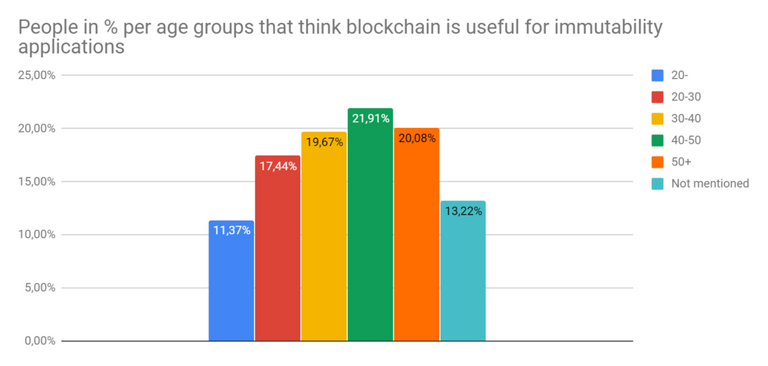
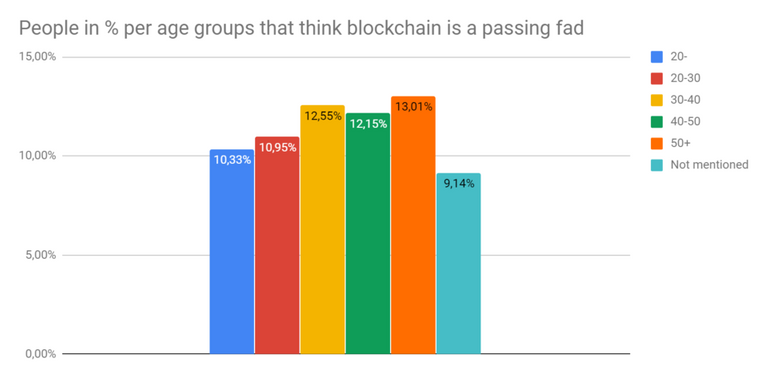

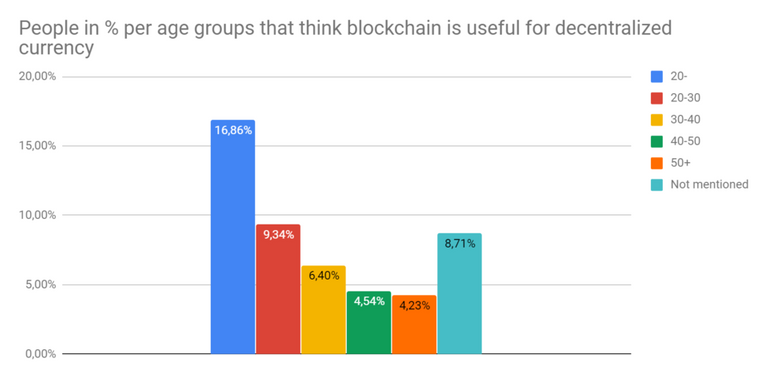

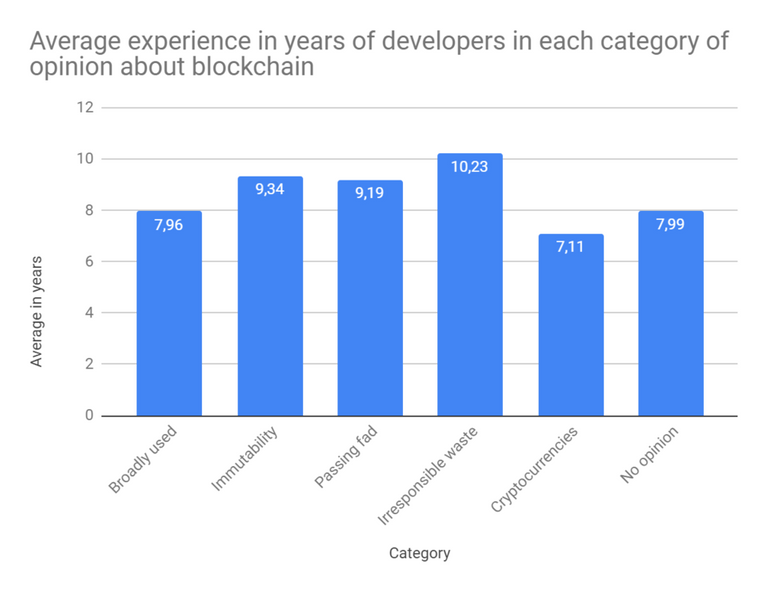
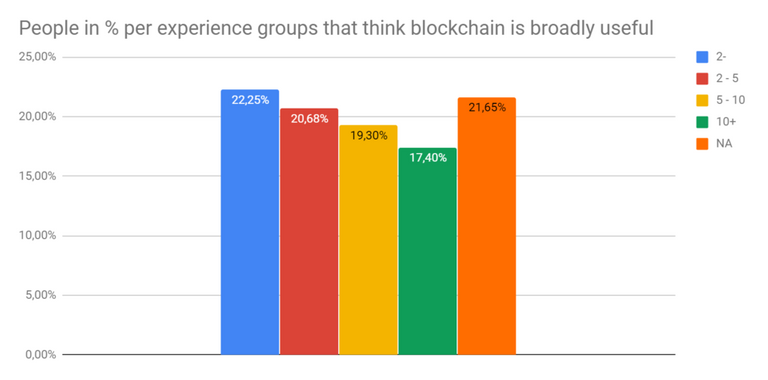
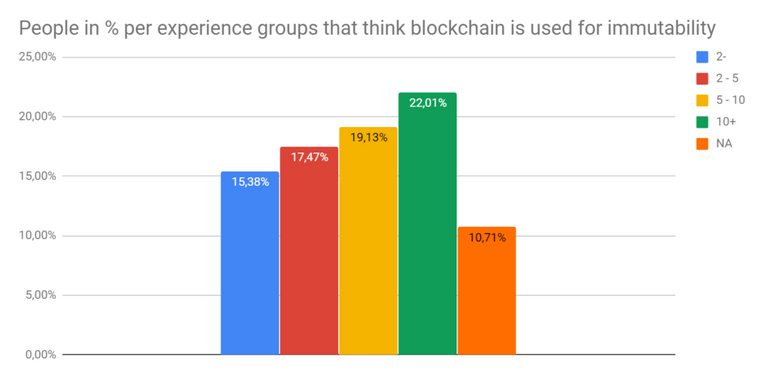
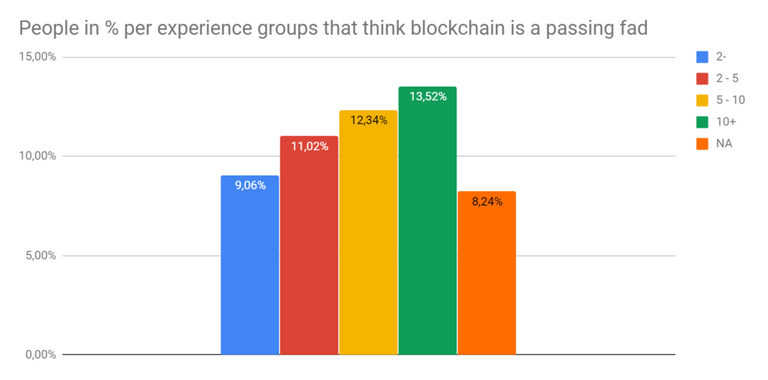
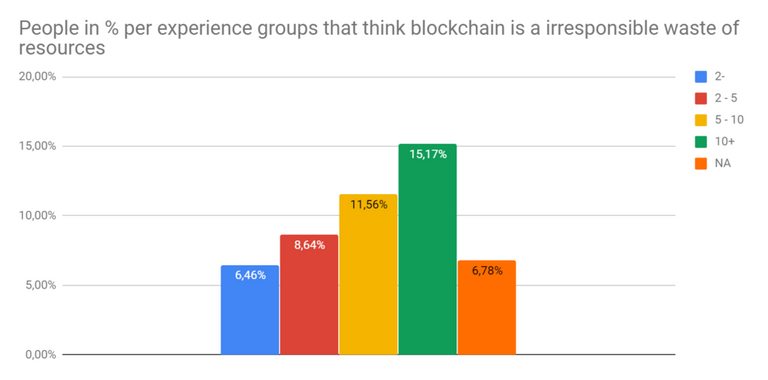

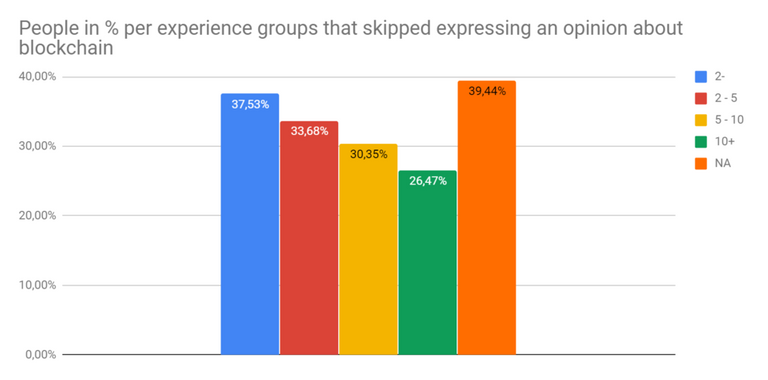
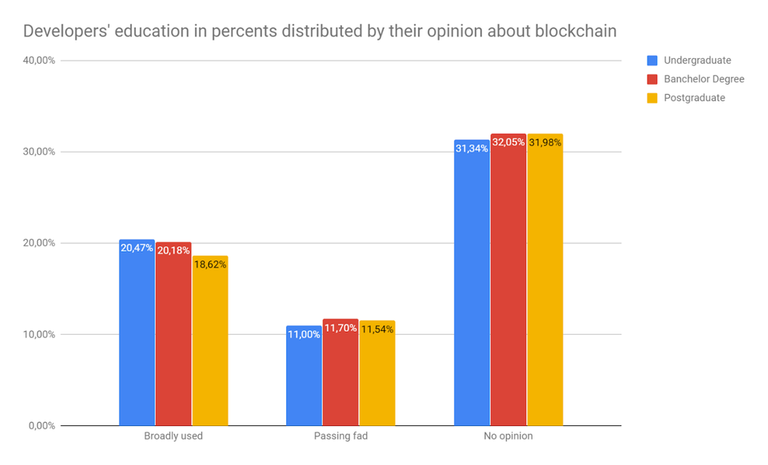
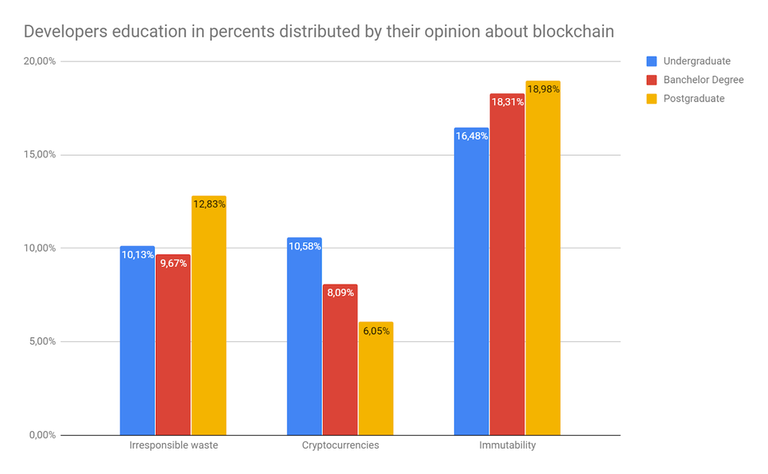

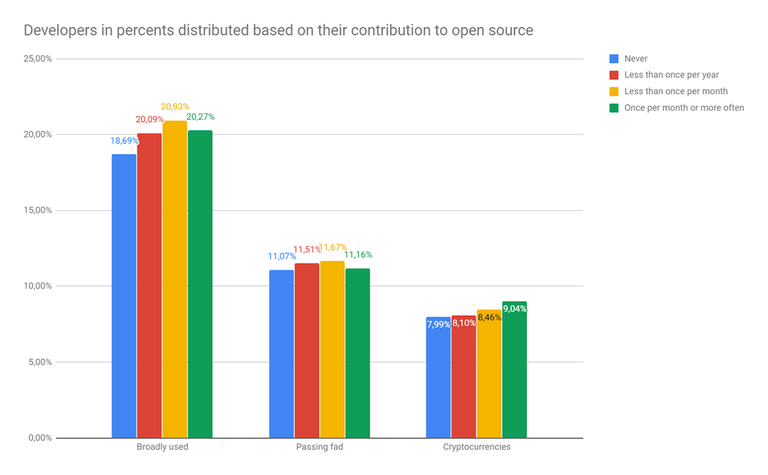
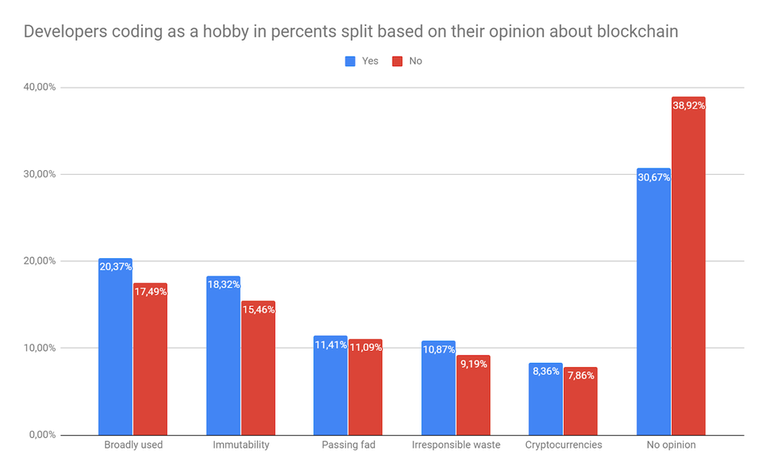

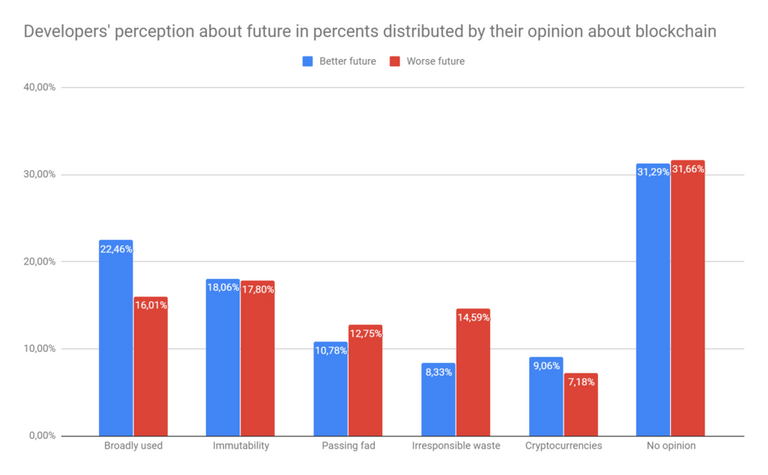
Haven't read it yet...I will after this...
You should put a Palnet Tag on it!
Posted using Partiko Android
I don't know what is palnet :) I am not so up to date to the news around here. I know it's long so it's no need to read it all, just let me know what you think about the parts you have read.
Well, I know that you know what busy.org is...so Palnet is the same,the only difference is that you can earn,new coints/tokens...I should call them Steem-Alts...while you don't have to do anything special,don't even need to post from there like on Busy,just use a tag...just Steemconnect once at palnet.io there are many like this now...
Makes sense. Most likely will do that tomorrow :)
Have you got used to the new time zone?
Yes,no,maybe...don't know who to blame...I really do miss my bed...my back hurts like shit,can't sleep..😕
Posted using Partiko Android
I am also an investor, can we discuss it together, my whatapp+85251290766
Hello - I'm a software architect in a big banking computer center. Some Comment to your statement
"Keep in mind that these people whose answers are analysed below are developers, so the chances that they have been exposed already to the blockchain are far greater than regular people who do not have a solid programming or technical background"
My experience is that developers are not the people who are interested in the potential of the blockchain. They recognize it as another new technology and they will use it if required. Much more interested in blockchain are managers, business developers, banking experts, software architects and so on. I think developers are not more interested in blockchain than other people but maybe even less.
I can understand that developers may not be the most interested people in blockchain from all of the other professions, I should not have suggested this. What I am trying to say is them, being curious about what is new as a matter of technology are more likely to have heard of blockchain and understand how it is working, than many other people.
You gave as an example the people from a management position, the business developers or banking experts and software architects. That is right to some extent, part of these people are more interested in blockchain than regular developers. But keep in mind that not all the managers are working for a tech company so for them is pretty unlikely to get in touch with blockchain (hospitals manager's may never hear of blockchain).
On the other side, I have to mention that software architects were also included in this survey, as some software architects are active on Stackoverflow just as developers. I have called them developers in a more general fashion only for the sake of simplicity.
After all, I think that you have a very good point and I want to thank you for letting me and the rest of the readers see it. I have received good feedback about your comment from some peers of mine!
If the point is "who knows what a blockchain is", I will agree. On various opportunities we meet bank employees not dealing with IT development. They heard about Bitcoin or some other cryptocurrency and then ask us what a blockchain is and if blockchain is a serious trend. They usually don't have an idea what blockchain is. Or even worse they heard a little bit about blockchain an tell crazy things about blockchain :-).
I appreciate your answer. It helped me to better understand who was doing the survey.
No problem, I am trying to create value here so I am happy when I see people like you challenging my post with comments. I hope this article will help some people understanding how blockchain is perceived and what areas blockchain evangelists need to work on :)
Very good upvoted!
Congratulations @mejustandrew! You have completed the following achievement on the Steem blockchain and have been rewarded with new badge(s) :
You can view your badges on your Steem Board and compare to others on the Steem Ranking
If you no longer want to receive notifications, reply to this comment with the word
STOPVote for @Steemitboard as a witness to get one more award and increased upvotes!
Congratulations @mejustandrew! You received a personal award!
You can view your badges on your Steem Board and compare to others on the Steem Ranking
Vote for @Steemitboard as a witness to get one more award and increased upvotes!